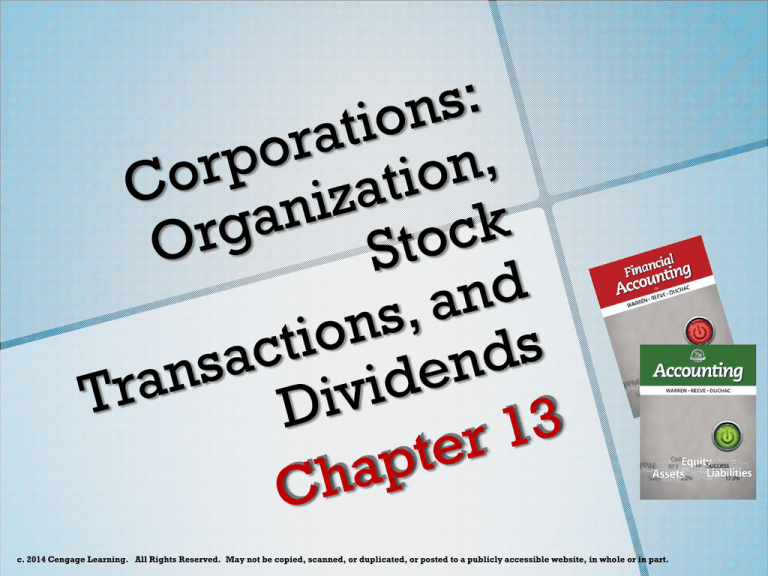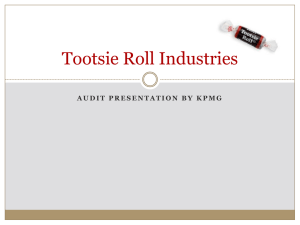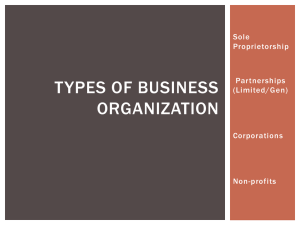
c. 2014 Cengage Learning. All Rights Reserved. May not be copied, scanned, or duplicated, or posted to a publicly accessible website, in whole or in part.
Learning Objectives
1.Describe the nature of the corporate form of
organization.
2.Describe the two main sources of stockholders’
equity.
3.Describe and illustrate the characteristics of
stock, classes of stock, and entries for issuing
stock.
4.Describe and illustrate the accounting for cash
dividends and stock dividends.
5.Describe and illustrate the accounting for
treasury stock transactions.
Learning Objectives
6.
Describe and illustrate the reporting of
stockholders’ equity.
7.
Describe the effect of stock splits on
corporate financial statements.
8.
Describe and illustrate the use of earnings
per share in evaluating a company’s
profitability.
c. 2014 Cengage Learning. All Rights Reserved. May not be copied, scanned, or duplicated, or posted to a publicly accessible website, in whole or in part.
Characteristics of a Corporation
o A corporation is a legal entity, distinct and
separate from the individuals who create and
operate it. As a legal entity, a corporation may
acquire, own, and dispose of property in its
own name.
o A corporation sells shares of ownership, called
stock.
Characteristics of a Corporation
o The stockholders or shareholders who own the
stock own the corporation. They can buy and
sell stock without affecting the corporation’s
operations or continued existence.
Characteristics of a Corporation
o Corporations whose shares of stock are traded
in public markets are called public
corporations.
Characteristics of a Corporation
o Corporations whose shares are not traded
publicly are usually owned by a small group of
investors and are called nonpublic or private
corporations. The stockholders of all
corporations have limited liability.
Characteristics of a Corporation
o The stockholders control a corporation by
electing a board of directors. This board meets
periodically to establish corporate policy. It
also selects the chief executive officer (CEO)
and other major officers.
CHARACTERISTICS
OF A CORPORATION
Characteristics of a Corporation
o A corporation has separate legal existence
from its owners.
o A corporation has transferable units of
ownership.
o A corporation has limited stockholders’
liability.
o A corporation is subject to taxes. Thus, the
corporate form has the disadvantage of double
taxation.
CHARACTERISTICS
OF A CORPORATION
(continued)
CHARACTERISTICS
OF A CORPORATION
Forming a Corporation
o The first step in forming a corporation is to file
an application of incorporation with the state.
Because state laws differ, corporations often
organize in states with more favorable laws.
More than half of the largest companies are
incorporated in Delaware (see Exhibit 3, next
slide).
FORMING A
CORPORATION
Forming a Corporation
o After the application is approved, the state
grants a charter or articles of incorporation,
which formally create the corporation.
o Management and the board of directors then
prepare bylaws which are operating rules and
procedures for conducting the corporation’s
affairs.
Forming a Corporation
o Costs may be incurred in organizing a
corporation, such as legal fees, taxes, license
fees, and promotional costs. The recording of a
corporation’s organizing costs of $8,500 on
January 5 is shown below:
c. 2014 Cengage Learning. All Rights Reserved. May not be copied, scanned, or duplicated, or posted to a publicly accessible website, in whole or in part.
Stockholders’ Equity
o The owner’s equity in a corporation is called
stockholders’ equity, shareholders’ equity,
shareholders’ investment, or capital.
STOCKHOLDERS’ EQUITY
Stockholders’ equity is
reported by its two
main sources.
Capital contributed to
the corporation by the
stockholders, called
paid-in capital or
contributed capital.
Net income retained
in the business, called
retained earnings.
Stockholders’ Equity
If there is only one class
of stock, the account is
entitled Common Stock
or Capital Stock.
Stockholders’ Equity
o Retained earnings is a corporation’s
cumulative net income that has not been
distributed as dividends.
o Dividends are distributions of a corporation’s
earnings to stockholders.
Stockholders’ Equity
o A debit balance in Retained Earnings is called
a deficit. Such a balance often results from
accumulated net losses.
o A credit balance in Retained Earnings does not
represent surplus cash or cash left over for
dividends.
c. 2014 Cengage Learning. All Rights Reserved. May not be copied, scanned, or duplicated, or posted to a publicly accessible website, in whole or in part.
Characteristics of Stock
o The number of shares of stock that a
corporation is authorized to issue is stated in
the charter.
o The term issued refers to the shares issued to
the stockholders.
o A corporation may reacquire some of the stock
that has been issued. The stock remaining in
the hands of stockholders is then called
outstanding stock.
CHARACTERISTICS
OF STOCK
Outstanding
Characteristics of Stock
o Corporations may issue stock certificates to
stockholders to document their ownership.
o Shares of stock are often assigned a dollar
amount, called par value.
o Some corporations have stopped issuing stock
certificates except on special request.
Characteristics of Stock
o Stock issued without par is called no-par stock.
Some states require the board of directors to
assign a stated value to no-par stock.
o Some state laws require that corporations
maintain a minimum stockholder contribution,
called legal capital, to protect creditors.
Characteristics of Stock
o The major rights that accompany ownership of
a share of stock are as follows:
The right to vote in matters concerning the
corporation.
The right to share in distributions of earnings.
The right to share in assets upon liquidation.
Classes of Stock
o The two primary classes of paid-in capital are
common stock and preferred stock.
o The primary attractiveness of preferred stock
is that it is given a preference to dividends
over common stock.
Classes of Stock
o The payment of dividends is authorized by the
corporation’s board of directors.
o When authorized, the directors are said to have
declared a dividend.
Classes of Stock
o Cumulative preferred stock has a right to
receive regular dividends that were not
declared (paid) in prior years.
Noncumulative preferred stock does not have this
right.
Cumulative preferred stock dividends that have not
been paid in prior years are said to be in arrears.
Classes of Stock
o A corporation has issued the following
preferred and common stock:
1,000 shares of $4 cumulative preferred stock, $50 par
4,000 shares of common stock, $15 par
o The corporation was organized on January 1,
2012, and paid no dividends in 2012 and 2013.
In 2014, the corporation paid $22,000 in
dividends, of which $12,000 was paid to
preferred stockholders and $10,000 was paid
to common stockholders.
(continued)
Classes of Stock
The 2012 dividends in arrears are paid first.
There are 1,000 shares, and each share
receives $4 for a total of $4,000.
(continued)
Classes of Stock
The 2013 dividends in arrears are paid next. Again, the
preferred stockholders receive $4 for each share held.
(continued)
Classes of Stock
The current dividends for 2014 must be paid to
preferred stockholders before common stockholders
can participate in the dividends.
(continued)
Classes of Stock
Of the $22,000 in dividends declared, preferred
must receive $12,000 before common can receive
any dividends.
(continued)
Classes of Stock
Dividends available to common stockholders
Issuing Stock
o A corporation is authorized to issue 10,000
shares of preferred stock, $100 par, and
100,000 shares of common stock, $20 par. Onehalf of each class of authorized shares is issued
at par for cash.
Issuing Stock
o If the stock is issued (sold) for a price that is
more than its par, the stock has been sold at a
premium.
o If the stock is issued (sold) for a price that is
less than its par, the stock has been sold at a
discount.
Premium on Stock
o Caldwell Company issues 2,000 shares of $50
par preferred stock for cash at $55.
Premium on Stock
o A corporation acquired land for which the fair
market value cannot be determined. In
exchange for the land, the corporation issued
10,000 shares of $10 par common that had a
current market value of $12.
No-Par Stock
o On January 9, a corporation issues 10,000
shares of no-par common stock at $40 a share.
On June 27, the corporation issues an
additional 1,000 shares at $36.
No-Par Stock
o Some states require that the entire proceeds
from the issue of no-par stock be recorded as
legal capital. In other states, no-par stock may
be assigned a stated value per share.
No-Par Stock
o Using the same data as in the previous
transaction, assume that the stock is assigned a
stated value of $25.
c. 2014 Cengage Learning. All Rights Reserved. May not be copied, scanned, or duplicated, or posted to a publicly accessible website, in whole or in part.
Cash Dividends
o A cash distribution of earnings by a
corporation to its stockholders is called a cash
dividend. The three conditions a corporation
must meet to pay a cash dividend are as
follows:
Sufficient retained earnings
Sufficient cash
Formal action by the board of directors
Cash Dividends
o The date of declaration is the date the board of
directors formally authorizes the payment of
the dividend. On this date, the corporation
incurs the liability to pay the amount of the
dividend.
Cash Dividends
o The date of record is the date the corporation
uses to determine which stockholders will
receive the dividend.
Cash Dividends
o The date of payment is the date the corporation
will pay the dividends to the stockholders who
owned the stock on the date of record.
Cash Dividends
o On October 1, Hiber Corporation declares the
cash dividends shown below with a date of
record of November 10 and a date of payment
of December 2.
Cash Dividends
o On October 1, the declaration date, Hiber
Corporation records the following entry:
Cash Dividends
o On November 10, the date of record, no entry
is required, since this date merely determines
which stockholders will receive the dividends.
Cash Dividends
o On December 2, the date of payment, Hiber
Corporation records the payment of the
dividends as follows:
Stock Dividends
o A distribution of dividends to stockholders in
the form of the firm’s own shares is called a
stock dividend. Stock dividends normally are
declared only on common stock and issued to
common stockholders.
Stock Dividends
o On December 15, the board of directors of
Hendrix Corporation declares a 5 percent
stock dividend of 100,000 shares (2,000,000
shares × 5%) to be issued on January 10 to
stockholders of record on December 31. The
market price on the declaration date is $31 per
share.
Stock Dividends
o The entry to record the declaration of the 5
percent stock dividend is as follows:
Stock Dividends
o At the end of the period, the stock dividends
distributable and paid-in capital in excess of
par—common stock accounts are reported in
the Paid-In Capital section of the balance
sheet. Thus, the effect of the preceding stock
dividend is to transfer $3,100,000 of retained
earnings to paid-in capital.
Stock Dividends
o On January 10, the stock dividend is
distributed to stockholders by issuing 100,000
shares of common stock. The following entry
records the issue of the stock:
Stock Dividends
o Before and After Stock Dividend Distribution
Total shares issued
After 6%
Before
Stock Dividend Stock Dividend
10,000
10,600
10,000 + (10,000 x 6%)
Stock Dividends
o Before and After Stock Dividend Distribution
Total shares issued
Number of shares owned
by one stockholder
After 6%
Before
Stock Dividend Stock Dividend
10,000
10,600
1,000
1,060
1,000 + (1,000 x 6%)
Stock Dividends
o Before and After Stock Dividend Distribution
Total shares issued
Number of shares owned
by one stockholder
Proportionate ownership
After 6%
Before
Stock Dividend Stock Dividend
10,000
10,600
1,000
10%
1,000 ÷ 10,000
1,060
10%
1,060 ÷ 10,600
c. 2014 Cengage Learning. All Rights Reserved. May not be copied, scanned, or duplicated, or posted to a publicly accessible website, in whole or in part.
Treasury Stock Transactions
o Treasury stock is stock that a corporation has
issued and then reacquired. A corporation may
purchase its own stock for a variety of reasons,
including the following:
To provide shares for resale to employees
To reissue as bonuses to employees, or
To support the market price of the stock
Treasury Stock Transactions
o On February 13, a firm purchased 1,000 shares
of treasury stock (common stock, $25 par) at
$45 per share. The cost method for accounting
for treasury stock is used. The entry to record
the purchase of the treasury stock is as follows:
Treasury Stock Transactions
o On April 29, the corporation sells 600 shares of
the treasury stock for $60. The entry to record
the sale is as follows:
*
The amount (per share) debited to Treasury Stock
when purchased is the amount per share that must
be credited to that account when sold (600 x $45).
Treasury Stock Transactions
o On October 4, the corporation sells the
remaining 400 shares of treasury stock for $40
per share. The entry to record the sale is as
follows:
c. 2014 Cengage Learning. All Rights Reserved. May not be copied, scanned, or duplicated, or posted to a publicly accessible website, in whole or in part.
Reporting Stockholders’ Equity
o Exhibit 4 shows two methods for reporting
stockholders’ equity for the December 31,
2014, balance sheet of Telex Inc.
o In the first method, shown in the next slide,
each class of stock is reported, followed by its
related paid-in capital accounts. Retained
earnings is then reported, followed by a
deduction for treasury stock.
REPORTING
STOCKHOLDERS’
EQUITY
(continued)
Reporting Stockholders’ Equity
o In the second method, the stock accounts are
reported, followed by the paid-in capital
reported as a single item, Additional paid-in
capital. Retained earnings is then reported,
followed by a deduction for treasury stock.
Method 2 is shown on the next slide.
REPORTING
STOCKHOLDERS’
EQUITY
(concluded)
Reporting Retained Earnings
o Changes to retained earnings may be reported
using one of the following:
Separate retained earnings statement
Combined income and retained earnings statement
Statement of stockholders’ equity
REPORTING
RETAINING
EARNINGS
When a separate retained earnings
statement is prepared, the beginning
balance of retained earnings is reported.
Restrictions
o The retained earnings available for use as
dividends may be restricted by action of a
corporation’s board of directors.
o These amounts, called restrictions or
appropriations, remain part of the retained
earnings. However, they must be disclosed,
usually in the notes to the financial statements.
Restrictions
o Restrictions of retained earnings are classified
as follows:
Legal: State laws may require a restriction of
retained earnings.
Contractual: A corporation may enter into contracts
that require restrictions of retained earnings.
Discretionary: A corporation’s board of directors
may restrict retained earnings voluntarily.
Prior Period Adjustments
o Errors may not be discovered within the same
period in which they occur. The correction of
this type of error, called a prior period
adjustment, is reported in the retained
earnings statement as an adjustment to the
beginning balance of retained earnings.
Statement of Stockholders’ Equity
o When the only change to stockholders’ equity
is due to net income or net loss and dividends,
a retained earnings statement is sufficient.
o When a corporation also has changes in stock
and paid-in capital accounts, a statement of
stockholders’ equity is normally prepared.
STATEMENT OF
STOCKHOLDERS’
EQUITY
MORNIN’ JOE’S STATEMENTS
MORNIN’ JOE’S STATEMENTS
Mornin’ Joe’s retained earnings statement for the year
ended December 31, 2014, is as follows:
MORNIN’ JOE’S STATEMENTS
The statement of stockholders’ equity for Mornin’
Joe is shown below:
c. 2014 Cengage Learning. All Rights Reserved. May not be copied, scanned, or duplicated, or posted to a publicly accessible website, in whole or in part.
Stock Splits
o A stock split is a process by which a
corporation reduces the par or stated value of
its common stock and issues a proportionate
number of additional shares.
Stock Splits
o Rojek Corporation has 10,000 shares of $100
par common stock outstanding with a current
market price of $150 per share. The board of
directors declares the following stock split:
Each common shareholder will receive 5 shares for
each share held.
The par of each share of common stock will be
reduced to $20 ($100/5).
Stock Splits
c. 2014 Cengage Learning. All Rights Reserved. May not be copied, scanned, or duplicated, or posted to a publicly accessible website, in whole or in part.
Earnings per Share
o Earnings per common share (EPS), sometimes
called basic earnings per share, is the net
income per share of common stock
outstanding during a period.
o Earnings per share is computed as follows:
Earnings per Share =
Net Income – Preferred Dividends
Average Number of Common Shares
Outstanding
Earnings per Share
c. 2014 Cengage Learning. All Rights Reserved. May not be copied, scanned, or duplicated, or posted to a publicly accessible website, in whole or in part.









